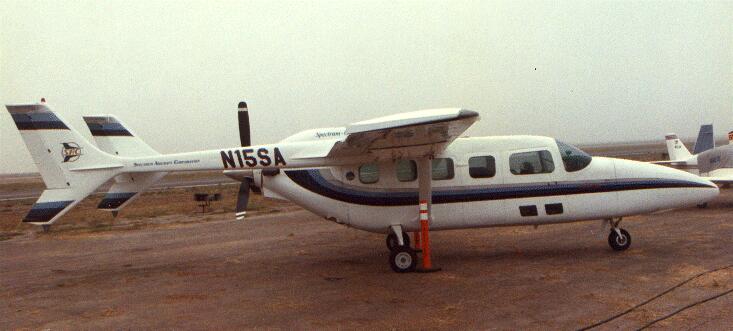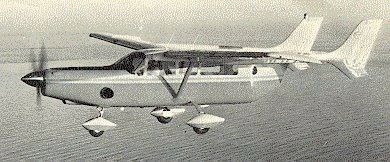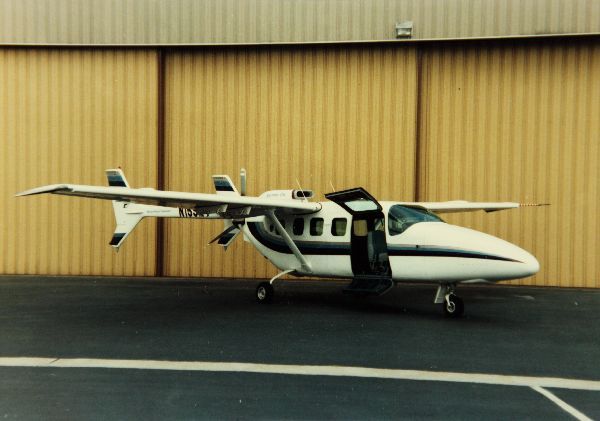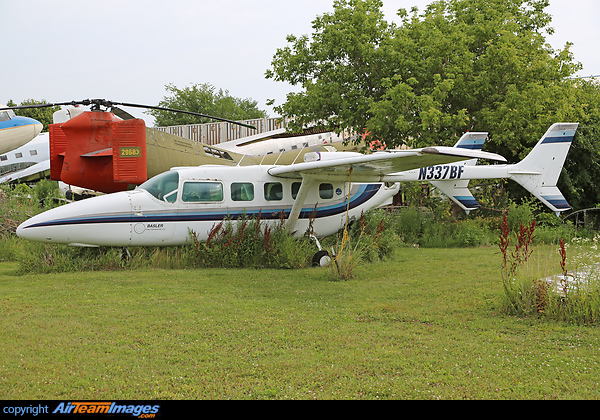Well, since we're on that topic, for you twin owners, what do you see in terms of routine annual inspection cost? I've always owned single engine planes and routine annuals (although I rarely had routine ones lol) run between $2,000 and $3,000. I assumed that with a twin (non pressurized), it would roughly double, plus a little extra for the landing gear so maybe $5,000 - $7,000 or am I completely off? I'm talking about twins like the Twin Comanche, Apache or similar planes.
You are using an out of date browser. It may not display this or other websites correctly.
You should upgrade or use an alternative browser.
You should upgrade or use an alternative browser.
Why are Cessna Skymasters not liked? Or are they?
- Thread starter Chrisgoesflying
- Start date
I have over 850 multi time and 3600 total time atp rated IFR currentPeople's reasoning can be their own, but for me it would be for STOL performance, visibility, and history.
It's always experience dependent, how much multi time do you have? Also after you have a 100 hours in type insurance usually drops off a cliff, so that's usually a "first year" only price that goes down subsequently.
Doc Holliday
En-Route
336's are not 337's with fixed gear, a common misconception.
The 336, while having fixed gear, also have a different rear cowling arrangement. This is where the OWT of rear engine heating problems on 337's arise from. The 337 has large cowl flaps (rear) and the scoop on top, plus rearranged baffling. So rear engine cooling is not a problem.
High cost annuals. Again, these are 40 year old airplanes that have gone through lots of cheap owners and "$200 annuals", and when someone gets one they end up (if maintained correctly) paying for all the past due maintenance. A well maintained 337 will cost no more than any other twin in the same category that is maintained as well.
Speed. A NA 337 will cruise at 160-165KTAS while burning 20gph total.
Noise. At TO power the engines are 2800rpm. The noise complaints come from airplanes still flying with the original Cessna insulation. Re insulate with modern materials and the noise drops to a level of a single engine Cessna.
Landing Gear. Again, a well maintained example is reliable. One that's been neglected most of it's life will be expensive.
The 336, while having fixed gear, also have a different rear cowling arrangement. This is where the OWT of rear engine heating problems on 337's arise from. The 337 has large cowl flaps (rear) and the scoop on top, plus rearranged baffling. So rear engine cooling is not a problem.
High cost annuals. Again, these are 40 year old airplanes that have gone through lots of cheap owners and "$200 annuals", and when someone gets one they end up (if maintained correctly) paying for all the past due maintenance. A well maintained 337 will cost no more than any other twin in the same category that is maintained as well.
Speed. A NA 337 will cruise at 160-165KTAS while burning 20gph total.
Noise. At TO power the engines are 2800rpm. The noise complaints come from airplanes still flying with the original Cessna insulation. Re insulate with modern materials and the noise drops to a level of a single engine Cessna.
Landing Gear. Again, a well maintained example is reliable. One that's been neglected most of it's life will be expensive.
EdFred
Taxi to Parking
That ain't a plane, it's a dude.
EdFred
Taxi to Parking
I have over 850 multi time and 3600 total time atp rated IFR current
And are up there in age, no offense. But that unfortunately and recently seems to be a bigger factor than experience according to bean counters.
Popular in Florida for overwater flights. I think the dudes from Miami who used to patrol for Cuban refugee boats had a fleet of them.
"Brothers To The Rescue" is the English version of the group name.
Doc Holliday
En-Route
The Air Force 0-2’s were an off the shelf airplane. The ones that served in Viet Nam were flown from Wichita all the way to VN.
In all of the crossings to and from, they only lost one. That loss was attributed to over servicing the engine oils in flight. They rigged a oil transfer system to add oil in flight.
In all of the crossings to and from, they only lost one. That loss was attributed to over servicing the engine oils in flight. They rigged a oil transfer system to add oil in flight.
LesGawlik
Line Up and Wait
- Joined
- May 6, 2006
- Messages
- 965
- Display Name
Display name:
Good Guy
Is there any way to put a 337 cowl on a 336? I am reaching the time when I won't be able to get insurance for a retract. The 336 is of interest to me, but I don't want to get one with overheating problems.
Pilawt
Final Approach
- Joined
- Sep 19, 2005
- Messages
- 9,486
- Display Name
Display name:
Pilawt
It's more than just the cowl.Is there any way to put a 337 cowl on a 336? I am reaching the time when I won't be able to get insurance for a retract. The 336 is of interest to me, but I don't want to get one with overheating problems.
Cessna had its hands full with rear-engine cooling on the original C-336, and tried several different configurations. They finally settled on an adjustable-height inlet at the top of the rear firewall, with an oddball axial exhaust fan on the rear prop shaft.
 [click to enlarge]
[click to enlarge]The fixed-gear C-336 was in production only for the 1964 model year. For 1965 it was replaced by the retractable C-337, with several design changes. There was a fixed rear intake scoop, resembling an upside-down P-51 scoop, with adjustable cowl flaps on the sides of the rear cowl. Wing incidence was increased by 2.5° to give the fuselage a more nose-down attitude in cruising flight. Elevator chord was increased by four inches, and the ventral fins shortened by six inches.

UngaWunga
Pattern Altitude
- Joined
- Oct 27, 2014
- Messages
- 1,988
- Display Name
Display name:
UngaWunga
I still think the 337 would be just about perfect with an IO-550 out front, and a rearward extended fuselage with C-5 type cargo loading doors.
Would make a fun jump-plane in that config.
MIFlyer
Pattern Altitude
OK, but maybe not as good of a jump plane as the other way around. You jump first?nahh, leave the engine in the back and make the front open, properly like a C5.
Tantalum
Final Approach
- Joined
- Feb 22, 2017
- Messages
- 9,236
- Display Name
Display name:
San_Diego_Pilot
One time useOK, but maybe not as good of a jump plane as the other way around. You jump first?
Pilawt
Final Approach
- Joined
- Sep 19, 2005
- Messages
- 9,486
- Display Name
Display name:
Pilawt
The Skymaster has lent itself to some pretty outrageous conversions over the years ...
AVE Mizar -- aka Flying Ford Pinto (1973 -- RIP)
https://en.wikipedia.org/wiki/AVE_Mizar

Groen Revcon autogyro (2001)
http://aviastar.org/helicopters_eng/groen_revcon.php


"Turbo Wing" C-337 conversion


AVE Mizar -- aka Flying Ford Pinto (1973 -- RIP)
https://en.wikipedia.org/wiki/AVE_Mizar

Groen Revcon autogyro (2001)
http://aviastar.org/helicopters_eng/groen_revcon.php


"Turbo Wing" C-337 conversion


Last edited:
Doc Holliday
En-Route
Doc Holliday
En-Route
- Joined
- Jul 21, 2014
- Messages
- 9,567
- Location
- Broken Arrow, OK
- Display Name
Display name:
SoonerAviator
The single pusher variant looks pretty sharp! Imagine if it had a PT-6 or similar hanging off the back. It looks like it would be a great XC bird with easy entry with the clamshell door up front.
Doc Holliday
En-Route
Imagine if it had a PT-6 or similar hanging off the back.
No need to imagine, it did.

EdFred
Taxi to Parking
The single pusher variant looks pretty sharp! Imagine if it had a PT-6 or similar hanging off the back. It looks like it would be a great XC bird with easy entry with the clamshell door up front.
Front clamshell seems like a wiring fiasco for avionics, and flight controls. What is this a Dodge Deora ?
Last edited:
- Joined
- Jul 21, 2014
- Messages
- 9,567
- Location
- Broken Arrow, OK
- Display Name
Display name:
SoonerAviator
Wiring fiascom Why wouldn't you just run the wiring harness in the floor or the left side of the fuselage?Front clamshell seems like a wiring fiasco for avionics, and flight controls. What is this a Dodge Deora ?
- Joined
- Jul 21, 2014
- Messages
- 9,567
- Location
- Broken Arrow, OK
- Display Name
Display name:
SoonerAviator
Awesome, couldn't tell by the pic with a quick glance that it was turbine.No need to imagine, it did.

EdFred
Taxi to Parking
Wiring fiascom Why wouldn't you just run the wiring harness in the floor or the left side of the fuselage?
Maybe we are picturing things differently. I see a lot of wiring and flight control slack being needed so the instrument panel and flight can rotate out of the way for easy entry. And I don't think I would want either of those things being slack.
It looks like it would be a great XC bird with easy entry with the clamshell door up front.
Is "clamshell door" the same as air stair door?Front clamshell seems like a wiring fiasco for avionics, and flight controls. What is this a Dodge Deora ?
- Joined
- Jul 21, 2014
- Messages
- 9,567
- Location
- Broken Arrow, OK
- Display Name
Display name:
SoonerAviator
From the one photo I found with the doors open, it appears that the doors are roughly centered with the co-pilot seat when slid rearward. So egress is probably done with the seat slid forward which doesn't require and special treatment of the controls that I can think of. My main thought was how much ballast they had to add to the nose to offset the loss of the forward engine, even though they extended the cabin.Maybe we are picturing things differently. I see a lot of wiring and flight control slack being needed so the instrument panel and flight can rotate out of the way for easy entry. And I don't think I would want either of those things being slack.
It's titled as a Spectrum SA-550, btw.
- Joined
- Jul 21, 2014
- Messages
- 9,567
- Location
- Broken Arrow, OK
- Display Name
Display name:
SoonerAviator
Similar I'd think, but air stairs can be a one piece door as well. Clam shell really just refers to the door design having an upper and lower that close. The clamshell doesn't necessarily have to even have stair steps on it.Is "clamshell door" the same as air stair door?
Capt. Geoffrey Thorpe
Touchdown! Greaser!
- Joined
- Jun 7, 2008
- Messages
- 15,780
- Location
- DXO124009
- Display Name
Display name:
Light and Sporty Guy
Maybe we are picturing things differently. I see a lot of wiring and flight control slack being needed so the instrument panel and flight can rotate out of the way for easy entry. And I don't think I would want either of those things being slack.

KLRDMD
Pre-takeoff checklist
I've had two 337s, actually, both were P337s (pressurized). They are reasonably safe, and reasonably fast on reasonable fuel with a reasonable useful load and reasonable insurance and maintenance. I liked mine although I preferred the Horton STOL over the Robertson STOL. But that R/STOL was an amazing airplane. They would do 182 KTAS at 17,500 ft on 23 GPH combined. In air-conditioned, turbocharged, pressurized comfort.
Attachments
Why do you no longer have one?I've had two 337s, actually, both were P337s (pressurized). They are reasonably safe, and reasonably fast on reasonable fuel with a reasonable useful load and reasonable insurance and maintenance. I liked mine although I preferred the Horton STOL over the Robertson STOL. But that R/STOL was an amazing airplane. They would do 182 KTAS at 17,500 ft on 23 GPH combined. In air-conditioned, turbocharged, pressurized comfort.
KLRDMD
Pre-takeoff checklist
Why do you no longer have one?
Mission changed and went back to a single. I have a Bonanza now.
Mtns2Skies
Final Approach
- Joined
- Jul 12, 2008
- Messages
- 5,630
- Display Name
Display name:
Mtns2Skies
Today I learned that a Skymaster will not climb, or maintain altitude with a rear engine failure, even with it feathered. To me that kind of defeats the purpose of having two engines...
KLRDMD
Pre-takeoff checklist
Today I learned that a Skymaster will not climb, or maintain altitude with a rear engine failure, even with it feathered. To me that kind of defeats the purpose of having two engines...
Did you hear this from someone that may not know what they're talking about or did you experience it for yourself? Mine would climb with the rear engine feathered. It was a P337 but I can't imagine a regular 337 wouldn't do the same. In my training for my ATP I shut down the rear engine and feathered it. I was at Prescott, AZ (KPRC) and able to maintain the 9,000 ft I was at and climbed to 10,000 ft.
Mtns2Skies
Final Approach
- Joined
- Jul 12, 2008
- Messages
- 5,630
- Display Name
Display name:
Mtns2Skies
I watched a video of it demonstrated with 2 people on board with half tanks. It was a regular 337, at 3,000'.Did you hear this from someone that may not know what they're talking about or did you experience it for yourself? Mine would climb with the rear engine feathered. It was a P337 but I can't imagine a regular 337 wouldn't do the same. In my training for my ATP I shut down the rear engine and feathered it. I was at Prescott, AZ (KPRC) and able to maintain the 9,000 ft I was at and climbed to 10,000 ft.
KLRDMD
Pre-takeoff checklist
From actually doing it myself I know it was possible with both of my P337s. I also know the POH of a normally aspirated one demonstrates the ability to climb with the rear engine feathered too so I wouldn't put much stock in a random video on the internet as gospel.
Doc Holliday
En-Route
I watched a video of it demonstrated with 2 people on board with half tanks. It was a regular 337, at 3,000'.
I’ve done it in a couple of NA 337’s heavier than that and had no problem climbing.
Main thing is you take what you can get, positive or negative(up drafts, down drafts). In my twin Comanche, I might not have been able to fly over the highest mountain, but I could travel hundreds of miles to lower terrain SE. What bites you is when you try to get more performance out of the twin than what you are getting at that time. Every time I take off, there is a time to cut your losses, true for even higher performing twins.



